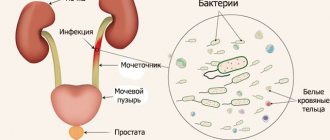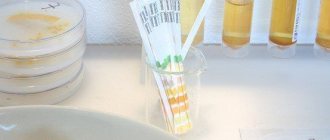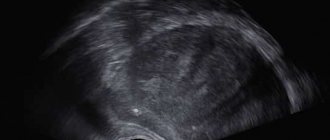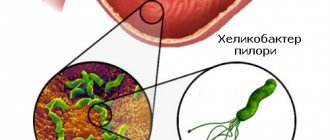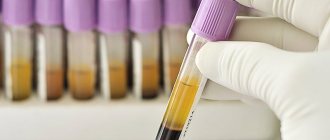One of the methods for studying the state of human health is bacteriological studies of human waste products, including feces. This type of analysis is usually included in both general preventive examinations and complex, highly specialized diagnostic measures. The collected material, processed in a special way, makes it possible to determine some important indicators of human health, for example, the presence of intestinal dysbiosis or intestinal infections, as well as to monitor the quality of the treatment provided. This analysis can be prescribed to patients of any age.
Why is intestinal microflora needed?
It is well known that the human intestine contains a large number of different microorganisms, a total of more than 500 species. Most of the microflora “live” in the large intestine, a smaller amount – in the small intestine and appendix.
Content:
- Why is intestinal microflora needed?
- Bacterial composition of intestinal microflora
- What is it prescribed for?
- Indications and contraindications for stool culture
- Requirements for collecting material for analysis
- How does the patient collect material for analysis?
- Taking stool for analysis in a laboratory or hospital
- How further processing of feces occurs
- Technique for bacteriological and scatological examination of stool
Although, at first glance, it may seem that their functional significance for humans is not particularly important, but in fact, the work of these bacteria is directly reflected in the health of their carrier.
In the intestinal cavity, bacteria attach to the villi of the epithelium. One of their functions is the production of a special mucous biofilm, which is responsible for maintaining the population of beneficial microorganisms and protects them from external influences.
During their life, bacteria actively multiply, participating in the processes of digestion of food and absorption of nutrients by the human body.
If foreign microorganisms enter, the “strangers” are destroyed, displaced, or their adaptation occurs, and they also begin to participate in the general activity of intestinal bacteria.
In addition to those described above, microorganisms in the intestine perform other functions - they break down and digest food, protect the epithelial inner layer of the intestine, participate in metabolic processes, synthesize some vitamins and amino acids, form reactions of the immune system, and protect against various pathogenic organisms.
At the same time, part of the microbiota of the intestine itself is opportunistic, such as E. coli. In normal quantities, it is indispensable in the digestive process.
Any changes in the quantitative or qualitative ratio of microflora in the intestine leads to a deterioration in human health.
Interpretation of results
When deciphering the result of urine culture, the severity of the clinical manifestations of urological infection, compliance with the method of collecting material, and the rules for transporting and storing samples must be taken into account.
All types of urological infections can be divided into mono- and mixed, occurring with the release of up to two types of pathogens.
If three or more pathogens are detected in the test material, the situation is considered as a sign of accidental contamination (contamination) of the urine sample. In this case, it is recommended to repeat the study in compliance with all stages of sampling and diagnosis.
Currently, all bacteria found in the urinary tract are usually divided into three groups, which affects their minimally significant diagnostic titer (when inoculating 1 μl):
- Primary pathogens (Escherichia coli, Salmonella, Mycobacteria, Leptospira). These microorganisms are obligate pathogens, their minimally significant diagnostic titer is more than 10x3 CFU/ml;
- Secondary pathogens (enterobacteriaceae, Klebsiella, Pseudomonas aeruginosa, Staphylococcus aureus, Haemophilus influenzae).
These pathogens are pathogenic only in certain conditions - when the immune system is weakened, after invasive medical procedures, with concomitant chronic conditions, their minimum diagnostic titer is 10x4 CFU/ml;
- Doubtful pathogens (coagulase-negative staphylococci, streptococcus agalactia, acinetobacter, Pseudomonas spp, their minimum diagnostic concentration is more than 10x5 CFU/ml.
Isolation of representatives of normal microflora, such as diphtheroids, gardnerella, alpha-hemolytic streptococci is not diagnostically significant.
Bacterial composition of intestinal microflora
For convenience, doctors classify all microorganisms that inhabit the intestinal cavity according to whether they can pose any danger to their carrier under certain conditions.
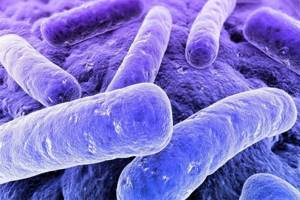
Thus, we distinguish:
- healthy bacteria that function in the intestines and do not cause harm to the carrier: lactobacilli, bifidobacteria, Escherichia;
- opportunistic microorganisms that can provoke the development of certain pathological processes under certain conditions: clostridia, staphylococci, candida, enterococci;
- pathogenic, which are causative agents of dangerous diseases: salmonella, shigella.
What is it prescribed for?
Analysis of stool for intestinal infections and dysbacteriosis allows us to identify all types of microorganisms, including pathogenic ones. The essence of the examination is to inoculate the excretions of the human body on nutrient media, as a result of which all the bacteria present in the stool begin to multiply intensively and become easy to detect. Often, a test, also called stool culture, is prescribed for children.
Based on the results of the analysis, the attending physician receives information about the presence of abnormalities in the intestines, the causes of disturbances in the digestive process, imbalance of microflora, and the presence of parasites and helminths in the intestines.
The main stages of self-collection of urine
The urine collection procedure described below is used for all adults, including pregnant women. The optimal volume of urine for microbiological analysis is approximately 10-20 ml, and the minimum volume should not be less than 1 ml.
The stages of independent collection of the research material can be presented as follows:
- 1Wash your hands thoroughly with soapy water and dry them with a clean (preferably disposable) towel;
- 2 Toilet the external genitalia using warm soapy water, without using skin antiseptics, dry the groin area with a clean disposable napkin;
- 3Open the previously prepared sterile container, avoiding touching its internal surfaces with your fingers;
- 4Release the first portion of urine, stop urinating;
- 5Collect the next (middle) portion into a prepared sterile container, without touching the skin in the groin area with the container;
- 6Finish urinating into the toilet;
- 7 Close the lid of the filled container tightly, sign it, attach the direction for analysis to the container with a thin rubber band, and deliver it to the laboratory.
It is unacceptable to use urine from a bedpan and urine from women during menstruation for microbiological research.
How to properly collect urine for bacterial culture from a child?
- 1Give the baby warm water or other liquid to drink (you can give the baby breastfeeding);
- 2Wash your hands with soapy water and dry with a clean towel;
- 3 Toilet the child’s external genitalia;
- 4If possible, collect a medium portion of urine by sitting the child on the assistant’s lap. If it is impossible to collect the middle portion, you can use a specially designed children's urinal, which should be checked at least every 10 minutes.
- 5Urine from a pot cannot be used for analysis.

Figure 2 - Collecting urine from an infant into a sterile urine bag
Indications and contraindications for stool culture
Stool examination is prescribed in certain cases when the doctor needs specific information about the patient’s health status. Indications for prescribing bacteriological examination of stool are:
- the need to prescribe antibiotics;
- preparation for conceiving a child;
- presence of digestive problems: constipation, diarrhea, heartburn, nausea and vomiting, heaviness in the stomach:
- stomach ache;
- increased gas formation;
- completed course of antibiotic treatment;
- manifestations of allergic reactions;
- frequent infectious diseases, suspicion of helminths;
- diagnosed cancer;
- immunodeficiency.
As for possible contraindications, this procedure does not have any - bacteriological examination of stool can be carried out at any age and in any condition of the patient.
Advantages and scopes of vacuum vessels
Containers for urine are compact and easy to use, made of durable indifferent materials, and meet sanitary and hygienic requirements. Due to its characteristics, it is possible to store biomaterial for chemical, cytological, biochemical, bacteriological studies, as well as PCR diagnostics.
The advantages of vacuum vessels are:
- functionality, tightness;
- ease of transportation and use;
- sterility of packaging;
- compatibility with other types of laboratory equipment;
- the use of preservatives to maintain the stability of biological media.
The selection of containers is carried out taking into account the intended purpose and has different volumes. ml container is standard. Volumes of 12.5 ml, 9.5 ml, 6.5 ml are also used.
Attention! Plastic products are disposable and must be disposed of after use. Glass vessels are used repeatedly and are subject to special treatment and disinfection.
Requirements for collecting material for analysis
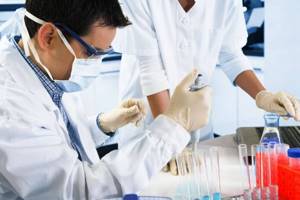
Carrying out a bacteriological analysis of stool requires certain preparatory measures from the patient. Feces are a waste product of the human body, which reflects the way it feeds.
Therefore, in order to ensure the most objective diagnosis, doctors recommend, first of all, to consult with your doctor and, approximately 5-7 days before sampling stool for pathogenic intestinal flora, stop taking antibiotics, anti-diarrhea drugs, anthelmintics, laxatives , enzyme-containing and iron-containing drugs. It is not recommended to do cleansing or therapeutic enemas 3-4 days in advance. The doctor who will conduct the test should be warned about all medications taken shortly before the test. If the subject has visited other countries in the last six months before the analysis, the doctor should also be informed about this.
As part of the patient's preparation, 2-3 days before the scheduled date of the test, you should follow a diet that excludes foods that increase gas formation or color the stool. Prohibited:
- legumes;
- beet;
- raw vegetables and fruits;
- bread and pastries;
- milk and dairy products;
- greenery;
- tomatoes;
- red fish.
When preparing a diet during this period, it should be remembered that eating meat can also affect the results of the analysis. It is not allowed to take stool for analysis that was obtained using laxatives or an enema. All these recommendations are relevant for planned collection of material.
How does the patient collect material for analysis?
There are several ways to collect stool for examination. In the first case, the patient collects biological material for study independently, after a voluntary defecation process. In this case, there are some requirements for the fence technique.
It is necessary to take care in advance of having a special sterile container for collected feces - you can purchase a container with a tight-fitting lid and a spatula at any pharmacy.
It is very important that the stool sent for analysis does not contain foreign impurities - urine, menstrual fluid, cleaning products from the toilet bowl. Women are advised to collect material after the end of menstruation.

If there is pus or mucus in the stool, it must be collected. Blood spots or clots should not be collected for analysis. Before collection, you must empty your bladder.
For analysis, a mass of approximately 2-3 teaspoons is sufficient, and it is necessary to select material from different parts of the mass - from the inside, from the sides, from above.
Having collected the material for research in a container, it must be tightly closed with a lid. On the container you should indicate your last name and initials, date of birth. Within no more than an hour and a half, the container with the contents must be delivered to the laboratory. Most often, special storage conditions cannot preserve the microflora of feces as much as possible, since most of the bacteria that enter it die from contact with oxygen. Five hours after collection, the material is no longer valuable for research.
During pregnancy
Tank. Urine culture during pregnancy is an integral type of research that is carried out twice: as soon as it becomes known about pregnancy, then literally a week before the preliminary date of birth. Diagnosis may be carried out more often if a general urine test is unsatisfactory during pregnancy.
It is worth noting that when treated with antibacterial drugs, a urine culture can be taken only a week after stopping antibiotic treatment. Otherwise, the results will be uninformative. Be healthy!
Taking stool for analysis in a laboratory or hospital
In some cases, material for research is collected by a medical professional, regardless of the patient’s natural bowel movement. Tampons or special loops can be used for this. This stool sampling algorithm is also suitable for small children.
The technique for collecting stool looks like this: the examinee lies down on the couch in the “sideways” position, bending his knees and pulling his hips towards his stomach. He needs to spread his buttocks with his palms. A loop or tampon is inserted into the anus to a depth of up to 10 centimeters, with which the nurse carefully removes the intestinal contents from the wall of the rectum.
The collected material is placed in a sterile tube, container or container with a preservative. Without a preservative, the material must be processed no later than 2 hours after its removal.
What it looks like and what it consists of
This type of laboratory glassware is specialized. Made from plastic or glass. Distinctive features are significant wall thickness, special structure, shape.
Thus, the vessels look like cylinders with lid holders equipped with thin sampling tubes. They are hermetically attached to a mini-hole in the lid so that atmospheric air does not penetrate through it. If necessary, the laboratory assistant can collect material with minimal contact with the external environment.
Like other containers , they can have a round bottom or be conical. Some systems are equipped with stabilizers, others do not.
The following are used as preservatives:
- boric acid (inhibits the growth and development of microorganisms);
- stabilizer "Stabilur" (helps preserve the cellular structure of the biomaterial).
For a note. It is planned to produce containers without these additives. This is necessary for studies such as tests with test strips, sediment microscopy, albumin and creatinine calculations. A preservative in this case would distort the result of the analysis.
How further processing of feces occurs
After the material for analysis is received, it is sent to the laboratory in a sterile container.
As soon as possible from the moment of collecting stool, it is inoculated on a solid colored medium - Levin's medium or Bacto-agar F, as well as on accumulation medium (Kaufman, Muller). The crops made are sent to a thermostat for a day, where they are kept at a temperature of 37 degrees Celsius. If the feces were collected on a swab, it is applied to a cup with a solid colored medium and dispersed with a spatula. Within a day, the material is ready for examination.
Why is research necessary?
The purpose of bacteriological examination of urine for microflora is to identify pathogenic microflora (quantity, type of pathogen, etc.). Also tank. Sowing for microflora and sensitivity to antibacterial drugs makes it possible to determine which medications will be effective for a particular disease.
If we are talking about pregnancy, this type of diagnosis allows us to exclude possible pathologies, prevent serious illnesses and eliminate harm to the health of the mother and fetus.


